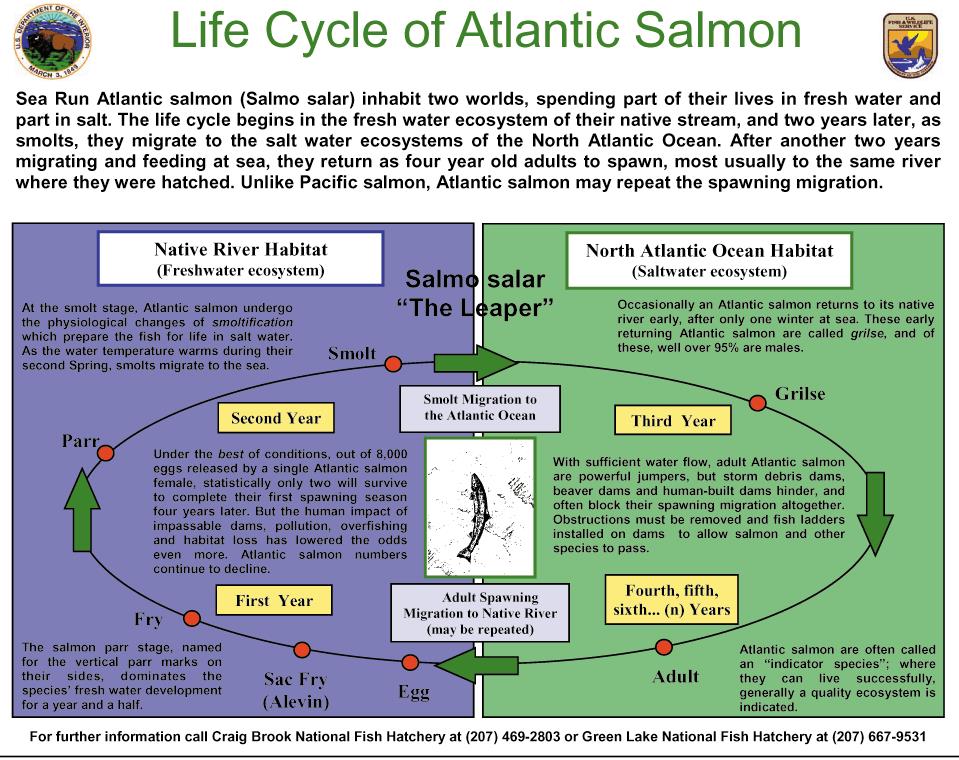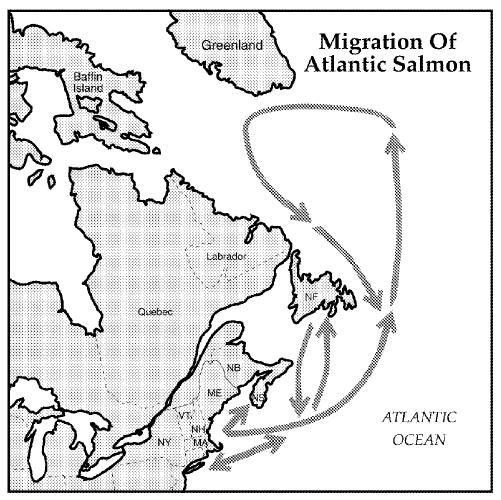The Atlantic salmon is an anadromous fish. Anadromous fish spawn in fresh water, live most of their adult life in the open ocean, and then return to their birthplace in freshwater as mature adults to spawn.
The Atlantic salmon’s life cycle can be organized into six stages. The life cycle begins in late fall when the mature male and female salmon begin their in a long journey home where they return to the river of their birth and spawn. Imprinted with the memory of the “smells” of their birthplace and journey to the ocean, Salmon are able to find their way back to the river of their birth using their sense of smell. After overcoming obstacles and challenges, the Atlantic salmon swim upstream, against the current, until they reach the place of their birth. Soon after they arrive, the female salmon digs a nest in the rocks and pebbles of the riverbed with her tail fin. This nest is approximately 6-8 inches deep and is called the redd. The female then lays up to 8,000 eggs. The eggs are about the size of a pencil eraser and fall safely into the rocks and crevices of the redd. Next, mature male salmon fertilizes the eggs by spraying sperm over the eggs. The fertilized eggs lay protected in the nest, or redd, in the benthic zone of the fresh water river. The Adult Atlantic salmon then return to the ocean to feed, and then repeat the cycle all over again when they journey back to their birth river to spawn again.
4

Used by permission of USFWS (United States Fish and Wildlife Services
Figure 3. Life Cycle of the Atlantic Salmon
The first stage of a salmon’s life cycle is called the alevin. This phase begins when the salmon hatches from the egg. The alevin are born with a yolk sac attached to its belly. Since the yolk sac provides needed nourishment, the alevin do not need to search for food. For this reason, the alevin are able to stay safely within the rocks crevices of the redd for about 3 months. During this time, the alevin grow to about 2 cm. long. The second stage of a salmon’s life cycle is called the fry. Once the yolk is absorbed, alevin become a fry. As a fry, salmon need to find their own food, thus the fry leave the redd, moving up from between the rocks and crevices of the riverbed to feed on microscopic insects and plankton. In this stage, the fry is considered a zooplankton because it is still too weak to swim against the current. The fry begin to drift with the current downstream toward the estuary. The fry continues to grow to 5- 7cm. and strengthen as it finds food and drifts downstream.
The third stage of the salmon’s life cycle is called a parr. The dark vertical markings with one red dot between each vertical mark along its body indicate the parr stage. As the salmons more fully enters the ecosystem, hunting for food, these vertical markings serve an important purpose, camouflaging this young vulnerable marine creature from its prey. Parr can remain in the river for 2- 5 years. This period depends on the water temperature and the availability of food.

https://en.wikipedia.org/wiki/Atlantic_salmon
Figure 4. Ocean migration of Atlantic salmon from the Connecticut River
The fourth stage of the salmon’s life cycle is called a smolt. In this stage the salmon is adapting to the salt water. This is a complex transformation because the salmon is changing both internally and externally. Externally the smolt begins to look different. The smolt is 12 to 24cm. in length and the vertical striped markings of the parr stage disappear. Instead, when salmon are smolts, they take on a silvery shiny look. Internally the organs of the salmon are adapting to survive in the salt water. Additionally, during this stage and journey downstream, odors of their native river are being imprinted on their brain/memory for their return journey home. Smoltification is competed when the salmon has made physical changes in its kidneys, an internal metamorphosis that allows the smolt to live in the salt water of the open ocean.
The fifth stage is the adult stage. During this stage, the Atlantic salmon migrate to Greenland. They move into the Atlantic Ocean where they travel approximately 3000 kilometers north along the coast of North America, embarking on their long journey to the waters off southwestern Greenland to feed. Once they arrive, the Atlantic salmon feed on small fish, artic squid, sand eel, and crustaceans, growing rapidly. Adult salmon live and feed in the ocean for a year or more. During this time, they are growing and storing fat for the return journey to the spawn in freshwater. They return to their native rivers between April and November. The Atlantic salmon stops feeding and live off their fat reserves when they travel through in the estuaries and arrive in the freshwater river.
The sixth stage of the salmon’s life cycle is when the salmon matures to reproduce. After spending one to three years at sea, the Atlantic salmon returns to their native river to spawn. In this stage, they are called Grilse. Salmon look different when they are mature and ready to spawn. Salmon swim upstream against the current, jumping over waterfalls, climbing up fish ladders, and scaling dams in order to find their spawning ground where they lay and fertilize the eggs beginning the cycle all over again ensuring the survival of their species.
5 6